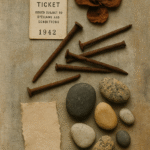Threads of Memory: Textile Storytelling in Women’s History
Growing up in Shimla, Winter meant a long-awaited journey to our ancestral home in Punjab. After school closed, we traveled for hours—from the hills to the plains—until we reached a large courtyard house that belonged to my great-grandfather. Built in 1896 after he returned from Lahore as a medical graduate, the house held not just people, but memories stitched into every corner.
While other children played, I found myself drawn to a shelf covered with delicately embroidered white cloth. My grandmother once told me stories behind those stitches—stories I only came to understand years later, when I picked up painting and began appreciating craft. That shelf cloth was more than fabric. It was memory made material. A quiet form of textile storytelling in women’s history.
A Feminine Archive Hidden in Thread
The embroidered pieces—whether shelf covers, bed sheets, or table cloths—were not merely decorative. They captured personal history in every motif. Amidst a household filled with duties, women still carved out time to sit with needle and thread. These were not grand gestures. But they were intimate ones.
Each flower, vine, or symbolic design was like a whispered message to future generations. In joint families with limited space and time, this was women’s only form of expression—one they passed down through practice, not speech. Today, platforms like Sahapedia and Indian Memory Project document these traditions, highlighting the value of domestic creativity as cultural preservation.
From Painting to Needlework: Recognizing Craft as Art
As a painter, I knew the patience it took to reach precision. But when I looked at embroidery with new eyes, I realized it required just as much—if not more. A single shelf cloth could take weeks to complete. The detailing, symmetry, and rhythm of color and thread showed how domestic labor had always been skilled labor.
Authors like Ismat Chughtai in Lihaaf (The Quilt) have used embroidery to symbolize hidden desires and female expression. Mahasweta Devi, in her activism and fiction, used cloth as a metaphor for resistance, weaving political meanings into material culture. These literary works prove that textile storytelling in women’s history is as rich as any written archive.
The Politics of the Personal: Gender and Fabric
In most Indian homes, textiles made by women remained in the shadows—used, cleaned, folded, and stored. Yet they carried imprints of emotional lives, joys, and sorrows. The absence of these in mainstream histories is a reminder of how often women’s voices are overlooked.
That’s why it’s vital to recognize the silent force behind these stitches. They represent more than labor. They speak of resilience, repetition, patience, and artistry passed through generations. Through embroidery, women stitched themselves into history, quietly but insistently.
Conclusion: Listening to the Threads
Today, when I hold that old shelf cloth, I no longer see it as just linen. It is a portal. A story passed on through tactile memory. It is part of a broader fabric of stories waiting to be re-sewn into our collective understanding.
Textile storytelling in women’s history helps us read the emotional and cultural layers embedded in cloth. It’s a reminder that sometimes, the quietest forms of expression carry the loudest truths—if only we pause to look.
Read our article on Ismat Chugtai’s Lihaaf
Suggested Reads:


